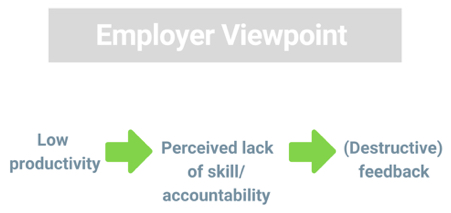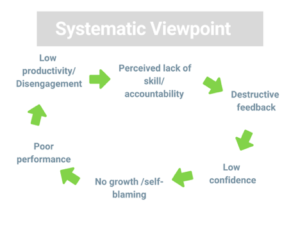No More Painkillers For Employee Engagement Pains
Workforce problems are becoming more complex and managing this complexity is becoming more important than ever. Companies work hard to stay competitive by investing a lot of money and resources on employee training and engagement programs, but they still lose an immense amount of money due to lack of productivity. This is incredibly important because disengagement at work has been negatively impacting individuals’ well-being and their families, as well as company cash flows and the economy at large.
Asking New Questions Key
In other words, we keep investing more resources to overcome workforce obstacles without considering our own contribution to the obstacles. How much more money do we need to lose to understand that our approach to employee engagement is not working? How many more jobs do we want to switch in the name of finding “meaningful work?” When are we going to reflect on our approach to solving complicated problems?
As an example, if the sales team cannot meet their target, we provide higher incentives for them. If there is insufficient housing, we build more houses. If we have a problem with traffic, we build more roads. If there is food scarcity, the solution is to increase food production. Maybe it’s time to pause and re-think our engagement solutions.
Systems scientist, author and lecturer Peter Senge—who also founded founder the Society for Organizational Learning—has championed a new approach to our complicated problems through “system thinking.” System thinking enables you to obtain fundamental solutions to complicated problems.
What is System Thinking?
Let’s start with an example to help understand what System Thinking entails.
First, imagine that a disengaged employee is perceived by their employer as someone who either does not have the right skills to do the job or isn’t responsible enough. In turn, the employer provides feedback to help the employee improve their performance. (In the image below, “destructive” is in brackets because employers do not see the cause of the problem clearly. Thus, any feedback could be destructive to employees and leads to poorer performance.)

From the employee’s point of view, there is a lack of confidence in their own strengths or in the company, which leads them to either blame themselves or the company for not having opportunities for growth. As a result, their performance drops.

If we take both linear perspectives into account, we end up with what Senge describes as a “systematic viewpoint“ (ie. system thinking). Here, the employer responds to the employee’s lack of accountability/skills by providing (destructive) feedback on their performance, leading to the employee’s lack of confidence in themselves or the company. The end result is a two-way blaming game—more fuel for the fire of poor performance. The cycle will continue until either the employee quits or the employer lets the employee go.

What system thinking does is reveal the whole structure to help us focus on the interrelationship of the points rather than their individual qualities.
Linear Versus Systematic Viewpoints
In contrast, the more commonly applied “linear viewpoint” describes a scenario whereby each side focuses on their own short-term goals and responds without considering any long term negative impact to the system. One explanation for why we still use a linear viewpoint could be our tendency to find comfort in applying simple and familiar solutions. Thus, we keep repeating these so-called familiar solutions over and over again because they’re obvious to us, even though they don’t lead to desired outcomes.
A great example of how companies still adhere to a linear viewpoint is exemplified by the organizing of social events as a solution to cultivate meaningful relationships. However, meaningful relationships are achieved when teams can speak openly together about what is important to them; when they can learn together, fall together, win together and hold each other accountable. As such, social events are mostly symptomatic solutions rather than fundamental solutions.
The Question of Responsibility
Although a systematic viewpoint can help us understand employee engagement problems and see the system as a whole, it can complicate the perception of responsibility. The most common response we hear is, “There is nothing I can do—it’s the system.” From a linear viewpoint, when things go wrong there is only one locus of responsibility—“It’s HR or the management team’s responsibility.”
All in all, it ends up as a blame game.
On the other hand, with system thinking there is no segregation of responsibility; we are all part of a single system. As leaders and professionals, we need to join forces and master system thinking. We need to give up the assumption that there is an individual/agent responsible for creating an engaged workforce—everyone shares the responsibility. This doesn’t necessarily mean that everyone can equally influence the system, but it does mean that blaming will not lead to any desired outcomes.
Master System Thinking and Everyone Wins
System thinking is needed now more than ever, as we are all increasingly overwhelmed by the complexity of the workplace. Leaders and professionals should encourage everyone to see issues from a systematic viewpoint, to take a step back to observe the whole. This will allow them to create long-lasting fundamental solutions that stop the pain of employee engagement once and for all, rather than waste time and money along more linear lines.
We are spending the most valuable years of our lives in workplaces where we want to reach our full potential and find meaning in what we do. Therefore, it’s also our obligation to participate in restructuring our viewpoint towards employee engagement, see the system as a whole and invest our resources wisely.
Human brains, behaviour and interactions with their environment never fail to impress Samin Saadat . After spending long hours in psychology labs at UBC and completing her Masters at Sauder School of Business, she entered the workforce and observed a gap between what research suggests and what companies actually do to increase productivity and profitability. Now, Samin is on a mission to bridge this gap through Jalapeño Employee Engagement—leveraging technology to bring research findings to life to help companies save invaluable dollars and to help individuals enhance their quality of life.








